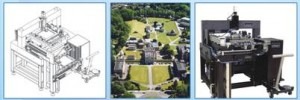
Aerotech has revealed that its ABL3600 engineered subsystem has been selected for use in an ultra-precision plate scanner at the Royal Observatory of Belgium (ROB).
The Damian ultra-precision scanning system at the ROB fulfils a part of a global programme for the digitisation of astrometric plates and aerial photographic images that have helped shape our understanding of the world, the solar system and the universe.
With more than three million plate images estimated in the astronomical community alone, the programme was developed from the need to provide a much-needed centralised archive to enhance the accuracy of predictive ephemerides and not least to preserve the work.
The ROB began development of the Damian (Digital Access to Metric Images Archives Network) digitiser with a study that produced design specifications for a 350 x 350mm X-Y scanning motion system.
To ensure the perfect reproducibility of the original analogue photographic images, the positional accuracy and repeatability targets needed to be an order above the inherent accuracy for the plates.
This value was interpreted in the region of 0.5microns over the whole scanning area with respect to a fixed telecentric objective of a digital camera system.
To ensure the fastest possible throughput, the motion system required a full move displacement of 10mm in less than half-a-second including acceleration, deceleration and settling time, and once in position the stability (jitter) requirement was 20nanometres.
These factors would ensure that the plates could be fully scanned and archived in minutes.
The machine specification also called for automatic loading of the glass photographic plates and film rolls, with a working duty cycle close to 24/7 continuous and unattended operation, so high reliability, low maintenance and long working life were critical factors.
The ROB selected Aerotech for a complete motion subsystem based upon its ABL3600 series open-frame air bearing table in a custom-engineered system that included a lapped granite base plate, a granite bridge with a vertical focusing axis for the camera and optical assembly, plus a photographic plate holder, plate storage tower and fully automatic transport system.
The Damian digitiser is housed in a temperature- and humidity-controlled clean room, maintained to within 0.1C and one per cent relative humidity.
Aerotech's ABL3600 series X-Y stage includes a preloaded, high-stiffness air bearing system featuring dual brushless and slot-less motors on each axis with glass-scale linear encoder servo feedback.
Two granite rails form a reference for the lower axis and both axes are referenced to a lapped granite surface plate with passive air isolation to maximise vibration stability.
In combination with this positioning system and fundamental to the machine's overall performance, Aerotech's linear technology servo amplifiers guarantee smooth motion, high bandwidth and good in-position stability with zero backlash or hysteresis.
The friction-free mechanics also provided the benefit of low maintenance and an essentially limitless working life.
The large through-aperture of the open-frame design allows back illumination for the plates and images.
The ABL3600 has been used in applications such as semiconductor fabrication and test, and is also suitable for demanding scanning microscopy, imaging and step-and-repeat positioning applications.
For the ROB, Aerotech extended the ABL3600's normal working travel range from 250mm to 350mm in both axes.
For such high-precision applications, Aerotech's Halar calibration firstly ensures high levels of accuracy, bi-directional repeatability, straightness and flatness for each axis and then performs error mapping with laser-based measurement systems at Aerotech's metrology lab, with the calibration file pre-configured on the motion controller.
During tests at Aerotech and on-site at the ROB, object locations on a calibrated test plate were repeated to within 70nanometres over a usable X-Y travel range of 335mm - this exceeded the original working specification.
Other results included geometric test for accuracy and repeatability to better than +/- 0.1micron and the displacement speed and in-position stability performance were fully met.
The Damian ultra-precision scanning system includes a full cable management system and was delivered complete with Aerotech's A3200 automation platform motion control system, which controls the main X-Y axes as well as several other motion axes for film wind, plate stacking and tray height adjustment.
The ROB took care of interfacing the A3200 to its own imaging software using a step-and-repeat procedure with alignment accuracy ensured using selected objects on the photographic media.
Images are recorded at standstill, hence the need for such high in-position stability.
The PC-based software-only motion and machine controller provides position, velocity and time information to Firewire interfaced linear technology servo drives.
A range of optional modules include HMI, soft PLC and vision control.
The fully deterministic controller can be programmed using Aerotech's Aerobasic, RS274 G-code and Labview.
Alternatively, programmers can call upon the Microsoft .NET development environment to help reduce project development timescales with C, C++, Visualbasic or Delphi based programming.
This application is fairly typical for Aerotech's engineered systems approach where customers provide their own specialised expertise in combination with a fully tested and certified motion subsystem, which fulfils an intrinsic 'enabling technology' element for the entire system.




